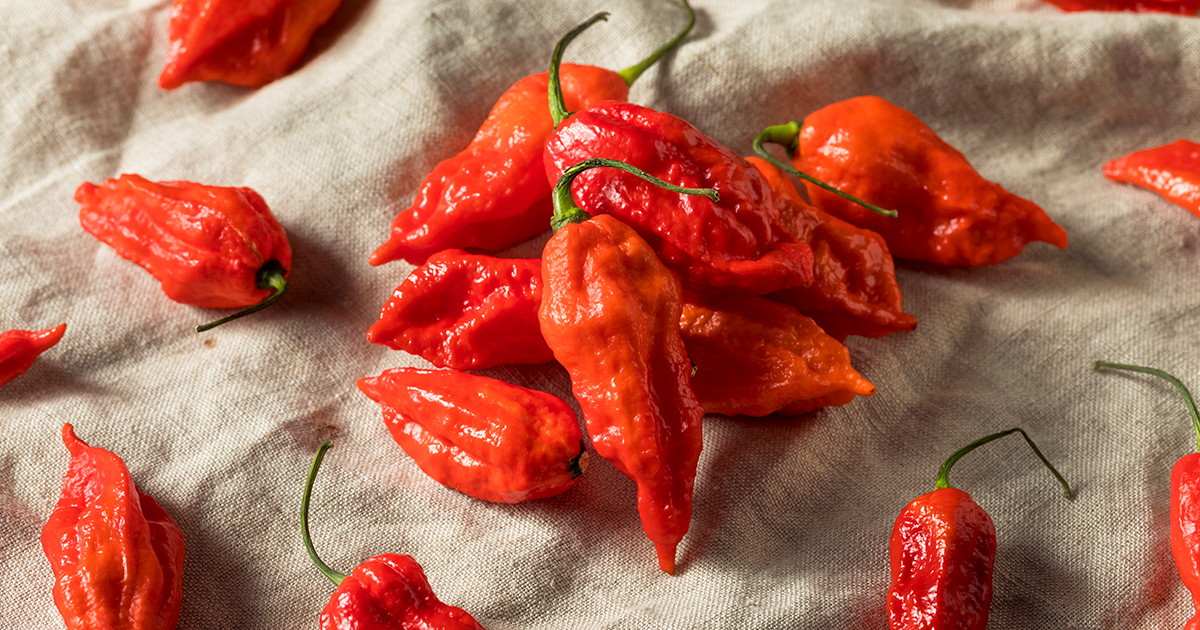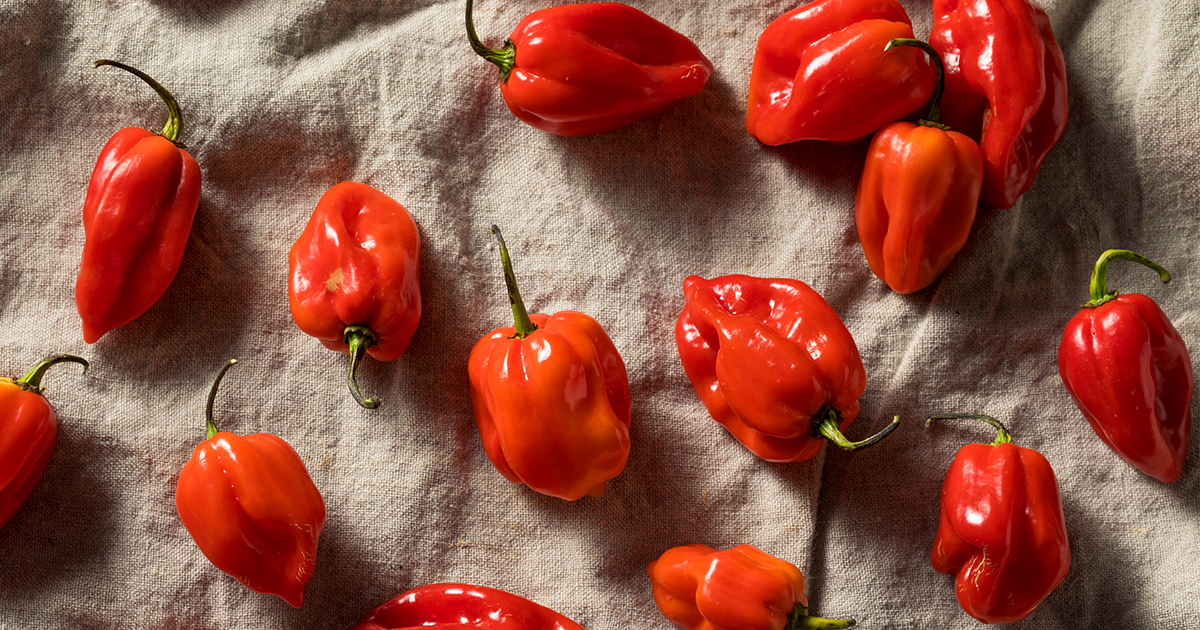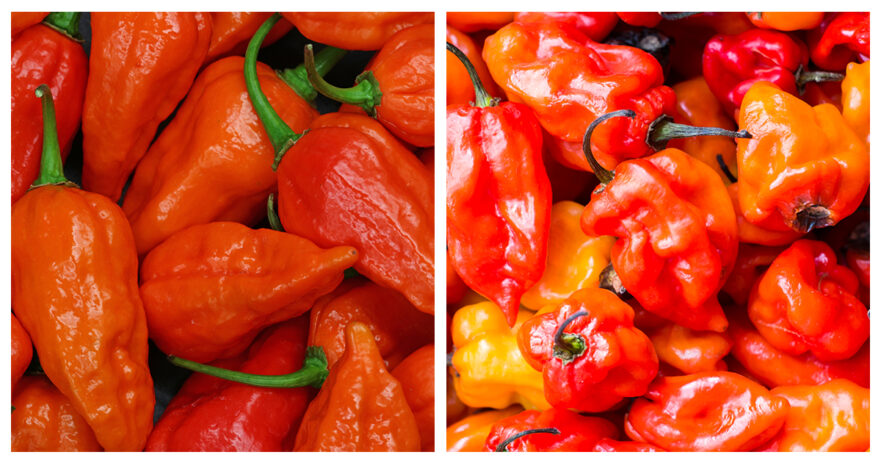Peppers have been used as a culinary ingredient across the globe, and the assortment of varieties available can leave you spoilt for choice. If you‘re a spice lover, then you’re probably familiar with the list of the hottest peppers in the world, which includes ghost peppers and habaneros. This article aims to explore the unique characteristics of ghost peppers and habaneros, allowing you to become a seasoned pepper connoisseur.
| Ghost pepper | Habanero pepper | |
| SHU | 855,000 - 1,041,427 | 100,000 - 350,000 |
| Median SHU | 948,214 | 225,000 |
| Flavor | Fruity and slightly sweet, with a very intense heat | Fruity and floral, sweet with a significant heat |
| Species | Hybrid of Capsicum chinense x Capsicum frutescens | Capsicum chinense |
| Origin | Northern India | Peru, today biggest producer is Yucatan Peninsula, Mexico |
| Uses | Hot sauces, salsas, curries, pickling, etc. | Salsas, hot sauces, jerk seasoning, marinades, etc. |
Table of contents
What are Ghost Peppers?

Ghost peppers, also known as Bhut Jolokia, are one of the hottest peppers in the world. These peppers have a Scoville rating of over 1,000,000, which means they‘re incredibly spicy. Originating from India, ghost peppers have a uniquely fruity and sort of sweet flavor that can add a burst of heat to any dish. The intense heat of ghost peppers comes from a chemical compound called capsaicin. This compound is what gives peppers their spiciness and also provides some health benefits. Capsaicin has been linked to pain relief, improved metabolism, and even reduced inflammation.
Ghost peppers are small and pod-like in shape with bumpy skin. They start out green and turn bright red when ripe. These peppers are a popular ingredient in spicy dishes, such as curries, chutneys, and marinades. They can also be used to add extra heat to sauces and dips.
When handling ghost peppers, it’s important to take certain precautions. The capsaicin levels in ghost peppers can cause skin irritation, burning, and even respiratory distress if you breathe it in. Remember to wear gloves when handling ghost peppers and to avoid touching your face or eyes. When you try cooking with ghost peppers, it’s best to start off with a small amount and then gradually increase to your desired level of heat.
Despite the challenges, growing ghost peppers can be such a rewarding experience. They need to have a warm climate, get plenty of sunlight, and be set in well-draining soil. These plants can be grown in containers or directly in the ground, and with the right care and attention, you can enjoy fresh ghost peppers all year. Whether you’re a seasoned pepper lover or new to the world of spicy food, ghost peppers are a must-try for anyone looking for a unique and intense flavor experience.
What are Habanero Peppers?

Habanero peppers are another well-known hot pepper variety. These peppers originally came from Peru, but the Yucatan Peninsula in Mexico is now the largest producer. Their Scoville rating sits around 100,000 to 350,000 SHU.
Habanero peppers have a distinctively fruity, floral flavor with a pretty significant level of heat to them. They‘re a popular ingredient especially in Caribbean and Mexican cuisine in things like jerk chicken, salsa, and hot sauces.
Habanero peppers remain a favorite among chili lovers thanks to their fun flavor profile. They can add a fiery kick to any dish you toss them in, but their flavor can sometimes be challenging to balance due to their extreme heat level. As such, it’s usually smarter to use them in small doses or to pair them with milder ingredients to avoid overwhelming the dish’s flavor.
Habanero peppers are small to medium-sized and have a lantern shape, along with a shiny skin. They start out green and turn either orange or red when ripe and ready to use. These peppers are incredibly versatile and can be used in all types of dishes, from spicy marinades all the way to sweet hot jams. They‘re also pretty popular for pickling and canning, too.
Habanero pepper plants, luckily, are relatively easy to grow, requiring not much aside from full sun and well-draining soil.
What Are the Similarities Between Ghost Peppers and Habanero Peppers?
Although ghost peppers and habanero peppers have tons of unique characteristics, there are a few similarities between these two types of peppers to note.
To start with, it’s worth noting that both of these peppers have become popular ingredients in many kinds of cuisines and can now be found across the globe, even though habanero peppers originate in South America, while ghost peppers hail from India.
Next up, both ghost peppers and habanero peppers are known and loved for their signature heat. While ghost peppers are definitely the hotter of the two, both can cause some discomfort if eaten in large amounts by non-professionals. As such, it’s important to handle these peppers with care and use them sparingly in dishes…unless you’ve got a high tolerance for spiciness.
Thirdly, ghost peppers and habanero peppers are each versatile little guys that can be used in a ton of various foods. Both peppers are perfect for adding a powerful kick to spicy sauces, marinades, and dips. They can also be easily used to add a touch of heat to sweet dishes such as jams and jellies.
Last but certainly not least, ghost peppers and habanero peppers are rich sources of capsaicin, which is the compound responsible for their spiciness. Capsaicin has been shown to be linked to several possible health benefits, such as reducing inflammation and boosting metabolism. However, it’s important to note that consuming too much capsaicin can lead to negative effects such as stomach irritation and pain.
What Are the Differences Between Ghost Peppers and Habanero Peppers?
Despite their many similarities, ghost peppers and habanero peppers have some pretty noticeable differences in their flavor, appearance, and culinary uses.
Ghost peppers give you a sweet, almost fruity taste and a very intense heat that can leave a lingering burn in the mouth. On the other hand, habanero peppers have a fruity and floral flavor with a type of heat that doesn‘t stick around as long as the ghost pepper’s.
When it comes to appearance, habanero peppers are going to be smaller than ghost peppers. Ghost peppers have wrinkled skin that can be red or orange-yellow when mature, measuring 1-2 inches wide and up to 3 inches long. Meanwhile, habanero peppers are about 1-2 inches long and 1-1.5 inches wide, with a lantern shape and a shiny skin that turns orange or red when ripe.
Another big difference between ghost peppers and habanero peppers is their availability. While habanero peppers are widely used in Mexican and Caribbean cuisine and are pretty easy to find in grocery stores and markets worldwide, ghost peppers are much less common, making them harder to find. This is in part due to their extreme heat, which can make them a little challenging to work with in the kitchen. Despite their limited availability, ghost peppers have still managed to gain a cult following among chili pepper enthusiasts who seek out the world’s hottest and spiciest varieties.
When it comes to the kitchen, both ghost peppers and habanero peppers can be used in plenty of ways, from adding extra heat to salsas and marinades to infusing into oil or vinegar for extra flavor.
Ghost peppers are popular in hot sauces, chutneys, and spice blends, while habanero peppers are a common ingredient in jerk seasoning, barbecue sauces, and even hot wings. Chefs and home cooks alike even prefer to use both peppers in the same dish to create a complex and layered flavor profile that balances intense heat with sweetness and acidity.
FAQ about ghost pepper and habanero
How are ghost peppers and habanero peppers different?
In terms of heat, ghost peppers are definitely hotter than habanero peppers. Ghost peppers offer a unique combination of fruity and sweet flavor, along with a whole lot of heat. In contrast, habanero peppers have a distinctly fruity and floral flavor, with a notable heat level that fades quicker compared to ghost peppers.
Are ghost peppers and habanero peppers both safe to eat?
Both peppers are definitely safe to eat in moderation, but consuming too much of either can cause discomfort in the stomach.
How do I handle ghost peppers and habanero peppers safely?
It's important to wear gloves when handling these peppers and to avoid touching your face or eyes. When you‘re cooking with them, start off with a small amount and gradually increase the heat to your desired level.
Can ghost peppers and habanero peppers be used interchangeably in recipes?
It’s not recommended. Ghost peppers are much hotter than habaneros.
Are ghost peppers and habanero peppers difficult to grow?
Both peppers require a warm climate, plenty of sunlight, and well-draining soil, but ghost peppers can be more challenging to grow. They‘re more susceptible to pests and diseases and require a bit more attention and care.
Can ghost peppers and habanero peppers be used in sweet dishes?
Absolutely! Both of these peppers can be used to add heat to sweet dishes such as jams and jellies.
